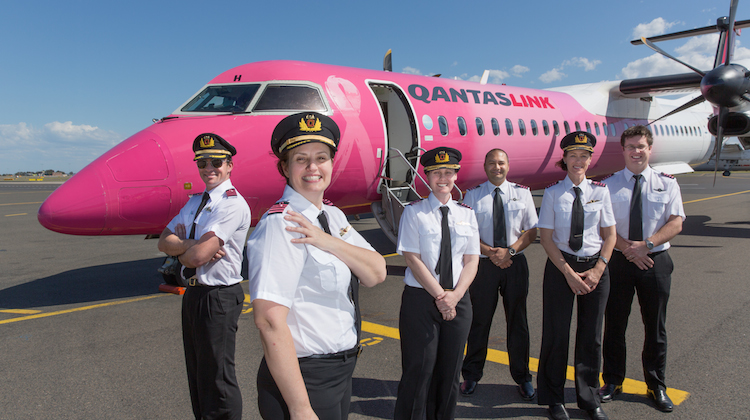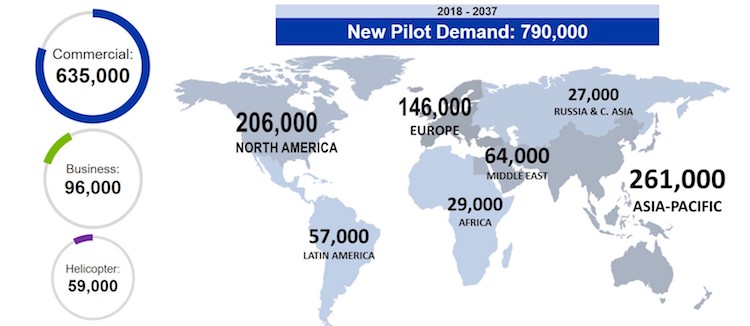
Qantas has secured approval from the federal government to recruit up to 76 overseas pilots and instructors for its regional wing QantasLink to help with pilot training.
The move, first reported in the Australian Financial Review on Monday, would target simulator instructors and experienced pilots.
The labour agreement with the federal government allowed the overseas pilots and instructors recruited by Qantas to stay in Australia for four years.
Under the current skilled worker visa rules, overseas aircraft maintenance engineers and pilots were only eligible to work in Australia for up to two years.
Qantas said the two-year contracts had proven uncompetitive in what it described as a global market for these sought-after skills, noting countries with the largest number of pilots qualified to operate the types of turboprop aircraft in the QantasLink fleet were from Canada, South Africa, the United Kingdom and United States.
Further, the instructors being brought to Australia would support QantasLink to get recruits through the training program and begin flying.
It said eligible senior pilots and instructors would have to reach the same capability standards and pass the same simulator assessments as existing pilots. They will also be employed on the same terms and conditions as its existing pilots and simulator instructors.
“Our focus has always been to recruit Australian-based pilots and that hasn’t changed,” a Qantas spokesperson said in a statement.
“This agreement allows us to temporarily bring in a limited number of simulator instructors and experienced pilots from overseas to support one of the biggest training programs we have done in our history.”

Skilled visa worker program was changed in 2017
In April 2017, the federal government announced it was ending the 457 temporary skilled worker visa scheme that was introduced by Prime Minister John Howard in 1996 and allowed companies to employ overseas workers for job vacancies difficult to find Australian workers for.
In its place were two new temporary skilled worker visas. The first is a two-year visa that includes one option to extend for two more years. However, visa holders will not be able to apply for permanent residency.
There is also a four-year temporary skilled worker visa that can be renewed. This visa does include a pathway for permanent residency in Australia after three years.
The federal government also cut scores of occupations that were eligible for the new visas, compared with the 457 visa, including pilots and aircraft maintenance engineers (avionics).
And those applying under the aircraft maintenance engineers (airframe and engine) categories would only be eligible for the short- term two-year visa and therefore not able to seek permanent residency.
After lobbying from the Regional Aviation Association of Australia (RAAA), and others, the federal government in late December added pilots back onto the list of applicable occupations for its temporary skilled worker visas.
However, pilots would only be able to apply for the two-year visa and would not be eligible to apply for permanent residency.
RAAA chief executive Mike Higgins said in the March 2018 edition of Australian Aviation the former 457 visa scheme had been used to bring experienced pilots into the country as cover for the exodus of Australian pilots to overseas carriers.
Further, Higgins said it was not being used as a source of pilots for normal crewing.
“We are not relying on the import of foreign captains forever and into the future, it is just so we can get these first officers trained up to take their place,” Higgins said at the time.
“We still have sufficient numbers of right-hand seat qualified pilots.”
The RAAA has been lobbying for pilots to be eligible for the four-year visa, rather than the two-year visa.
“The driving force behind the push for four-year visas for pilots is two- fold,” Higgins said.
“Firstly, it takes about four years of experience in the right-hand seat before you can sit in the left-hand seat and gain a command and during that four-year period there is a training and mentoring relationship that is very important and we would like to see that relationship unbroken so that’s why we are requesting four-year visas.”
“Secondly, the sort of experienced captains we’re looking for have obviously been flying for a couple of decades and are more likely to have families established and so forth, so to ask them to pack up and come halfway around the world for four years is much more attractive than say a two-year period.”
Qantas setting up pilot academy
The 2018-2037 Boeing Pilot and Technician Outlook showed 790,000 new pilots would be needed over the next two decades across the commercial, business and helicopter sector.
Further, it forecast demand for 754,000 new aviation technicians between now and 2037.
Asia Pacific represented the largest source of demand with 31 per cent of all new pilots, 34.1 per cent of all technicians and 36.1 per cent of all cabin crew to be recruited in the region between now and 2037.

Meanwhile, an expert industry panel review of the aviation training sector in this country has found Australia was experiencing a severe shortage of aviation personnel, with the situation getting worse.
“The current shortage of qualified pilots and aircraft maintenance engineers is a global problem and a major issue for Australia’s aviation system. Urgent action is required if the country is to avoid major disruptions,” the report published on July 27 stated.
The report was written by a panel of experts chaired by The Australian Aviation Associations Forum and comprising representatives from Aircraft Structural Contractors, Aviation Australia, Basair Aviation College, QantasLink, the Regional Aviation Association of Australia, the Regional Express Flight Training Academy and Virgin Australia.
The panel also consulted with more than 20 stakeholders in the aviation sector such as flight training schools, government departments, industry associations, regulators and universities.
It said Australia currently had an insufficient number of pilots with the necessary skills, experience and aptitude to fly and command aircraft operated by Australian airlines.
“The current pool of suitably qualified and experienced pilots is inadequate to meet the current levels of demand, with experienced Australian pilots being recruited by major international airlines to support the global expansion of air services,” the report said.
“Without action the gap between demand and supply is likely to grow, and grow quickly.”
“This is not a future threat, it is a significant present challenge that is currently disrupting the industry, and actions to address it need to include immediate mitigations supported by a longer-term sustainable strategy which involves many stakeholders.”
Locally, Qantas was due to announce the location for its proposed pilot training academy by the end of September.
Qantas said its labour agreement with the federal government would allow QantasLink to gradually restore flights that were dropped earlier this year due to its pilot training requirements.
Meanwhile, Virgin Australia’s 2019 pilot cadetship program, also conducted by Flight Training Adelaide in South Australia, would feature two ab initio courses starting in January and July 2019, the airline said in May.
Jetstar also has a pilot cadet program in partnership with the CAE Oxford Aviation Academy.
And Regional Express (Rex) established its Australian Airline Pilot Academy a decade ago. Located at Wagga Wagga, the school trains pilots for Rex’s operations as well as for foreign airlines.
Recently, Regional Express (Rex) publicly expressed its concerns over the impact of the global pilot shortage on its operations.
The airline said Australia was not spared from what it described as a global pilot shortage, with regional aviation the hardest hit as larger carriers actively recruited from this sector.
“Because of the critical pilot shortage, Rex is not able to have its usual contingent of stand-by pilots rostered for duty,” the airline said in what it described as an “open letter to all communities in the Rex network” on July 13.
















Edward
says:I am a permanent resident and senior co pilot with over 24 years service in airline industry. Last endorsement B777. I have a ATPL but cant find work as a pilot since 2015.
I believe Australia is going to employ overseas pilots. Can some Airline employ me over here.
Danny
says:What a way to employ overseas pilots ……i m 100%sure they are australian pilots that have they CPL BUT qantas Rex n Virgin wont give them a start …..but yet they get overseas pilots thstvalready have a airline job …. i wonder whats the australian doing about this …..i.e supporting the overseas pilots or supporting the australian unemployed pilots …. SHAME SHAME SHAME
Simmo
says:QantasLink is no friend of GA nor of regional Australia. RAAA(TS) now doing their bidding, I think the going rate is 30 pieces of silver.
AARON SINGH
says:I hold a CPL and under 30. FIt and fine cannot find a job . this is just crazy . AUSTRALIA WAKE UP . GIVE US YOUNG PILOTS A CHANCE
micahel
says:I’m Australian, I have my CPL and 800 TT wish i could get a job but hey i guess i’m not good enough for my own country thanks Qantas, apparently i’m more welcome to work for Cathay and other Chinese Airlines. How disappointing that i will have to leave the country i was born and raised in and wont be able to start my own family here !
sim
says:awkward!!!!! there are many Australian citizen with CPL and instructor licence not getting even interview and these big companies getting permission to bring overseas pilot and instructor, does it make any sense? who is negotiating with who to get legal permission to do this? how much money some people dealing behind the table, should not someone look into this? there need to be very high guard and more regulation’s need to put in place so that all these big company force to hire Australian citizen first unless they should pay 60% more tax than regular company who hire Australian citizen first.
David
says:I can agree with several of the previous comments. There are private and commercial pilots scattered all around Australia that cannot get jobs with the airlines. I suspect the problem is that the airlines can’t upskill these pilots. Whenever I keep hearing all this talk about pilots shortage I say “Where’s the WE WANT YOU add in the paper”! Nobody has knocked on my door yet, so how serious are they?
Archit
says:Pilot Shortage will be a big problem in the world in coming next 2-3 years.
Nico
says:Hey guys, it is frustrating but it is the same in most countries. The airlines are looking for 5000 hr plus guys…..they have plenty first officers to go around but not highly experienced people. If you get into Cathay with low time you are likely to be a P3 carrying the captain’s bag for a couple of years. Just keep pushing, shake the tree,NEVER say no to an opportunity, you never where it might lead….